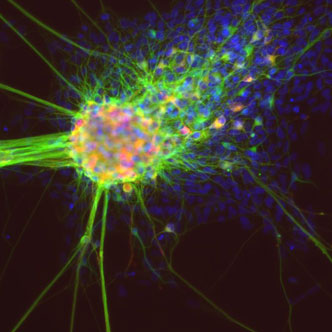
Our long term vision is to revolutionize drug discovery for neurodegenerative diseases
Drug discovery is a sector suffering from multiple, repeated failures. Over one billion people worldwide suffer from brain diseases, whose treatment costs annually € 1.4T in EU and US. Despite growing efforts and budgets dedicated by multinational pharmaceutical companies for drug discovery, brain drugs are 45% less likely to succeed and progress than non-brain drugs. The gap between the increasing demand for brain therapeutics and the decreasing success rate of new drugs is widening.
To help reverse this trend, we will bolster one of the weakest links in the drug discovery pipeline: the functional screening of compounds in vitro, via cellular assays1. While cellular assays are insuperable in giving experimental access to molecular and cellular function, they are limited by the loss of those cell-to-cell interactions governing native tissues. This is particularly detrimental for modelling brain pathology in vitro, where cultured neurons are isolated and deprived of native in-brain synaptic inputs that are fundamental for driving neuronal and network processing. Current technologies have little-if any- control over the network excitability, plasticity or connectivity; furthermore, they are limited to single cell or sparse observational readouts (e.g. by patch-clamp, optical imaging or Micro-Electrode Arrays, MEA). For these reasons, assessing how molecular deficits (e.g involving synaptic plasticity) and treatments modify the function of neuronal circuits remains a prohibitive challenge.
We propose a visionary and innovative hybrid technology, whereby nanoelectrodes and sophisticated computational models of neuronal circuits are combined to readout and manipulate activity/connectivity in cultured neuronal networks of Alzheimer’s disease, with subcellular accuracy.
For the first time ever, a biophysical model drives dendritic stimulation of Alzheimer’s cultured neurons, enabling i) to reproduce network connectivity and excitability, in addition to molecular features of the disease and ii) to drive the network to states that reveal deficits- e.g. by delivering plasticity-inducing stimuli- so as to optimize the assessment of drug effects. By increasing success rates in drug discovery, this technology is envisioned to reduce costs and minimize animal use prior to pre-clinical/clinical trials